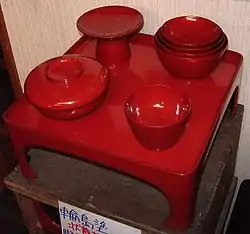漆
See also: 柒
| ||||||||
Translingual
Han character
漆 (Kangxi radical 85, 水+11, 14 strokes, cangjie input 水木人水 (EDOE), four-corner 34132, composition ⿰氵桼)
References
- KangXi: page 644, character 28
- Dai Kanwa Jiten: character 18108
- Dae Jaweon: page 1053, character 5
- Hanyu Da Zidian (first edition): volume 3, page 1716, character 9
- Unihan data for U+6F06
Chinese
Glyph origin
Characters in the same phonetic series (桼) (Zhengzhang, 2003)
Phono-semantic compound (形聲, OC *sʰiɡ) and ideogrammic compound (會意) : semantic 水 (“water”) + phonetic 桼 (OC *sʰiɡ, “resin used to make varnish”). From earlier 桼 (OC *sʰiɡ, “varnish; lacquer”).
Etymology 1
| trad. | 漆 | |
|---|---|---|
| simp. # | 漆 | |
| 2nd round simp. | 㲺 | |
| alternative forms | 桼 溙 | |
From Proto-Sino-Tibetan *r-tsəj (“medicine; juice; paint”). Cognate with Jingpho tsì (“medicine”), Tibetan རྩི (rtsi, “juice; fluid; paint”), Burmese ဆေး (hce:, “medicine; potion; poison; paint”).
Pronunciation
Definitions
漆
- lacquer tree; varnish tree (Toxicodendron vernicifluum)
- varnish; lacquer; paint
- to paint; to varnish
- (literary) black; dark
- Name of several rivers.
- a surname
Compounds
Pronunciation
Definitions
漆
- Only used in 漆漆.
Japanese
Etymology

漆 (urushi): a traditional red lacquerware serving set.
| Kanji in this term |
|---|
| 漆 |
| うるし Grade: S |
| kun’yomi |
Appears to be derived from Old Japanese root uru, as in terms such as classical Japanese 潤う (urufu) → modern 潤う (uruou, “to be moist”), うるうる (uruuru, “wetly, moistly”, adverb). Probably from the way that a lacquered surface glistens as if wet.
Descendants
- ⇒ English: urushiol
Korean
Vietnamese
Han character
- This term needs a translation to English. Please help out and add a translation, then remove the text
{{rfdef}}.
References
- Trần (2004).
This article is issued from Wiktionary. The text is licensed under Creative Commons - Attribution - Sharealike. Additional terms may apply for the media files.